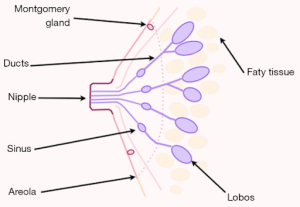Know Your Nipples: Which Type Is Yours?
- The nipple is the tissue found at the tip of the breast, while the areola is the pigmented skin surrounding it.
- Montgomery glands keep the nipple and the areola lubricated so they don’t dry up and can appear as tiny bumps.
- Nipples can be protruding, flat, puffy or even inverted. It is even possible to have two different or asymmetrical nipples in a pair!
- Supernumerary, hairy, and bumpy nipples are more common than you think—and absolutely normal.
With different faces, ears, and eyes, we are all so unique in our own ways—so are our nipples! They come in a multitude of shapes and sizes, yet we do not talk enough about them or appreciate the diversity they have to offer. In this article, we seek to explore, learn about, and celebrate all types of nipples.
Anatomy at a Glance
Before we dive right in, let us look at the anatomy of the nipple-areola complex.

The nipple is the tissue at the tip of the breast connected to ducts and nerve endings. The pigmented region surrounding the nipple is the areola. The areola also has glands called the Montgomery glands, whose main function is to lubricate and keep the nipple and areola from drying up. They can appear as small, painless bumps on the areola.
Types of Nipples
The nipple-areola combinations can vary on many parameters, whether it be the colour, shape, or size.
Colour
The colour of the areola often varies from a light pink to a deep brown or brownish black based on one’s ethnicity. One might experience a change in the colour of the nipples over time due to factors like puberty or pregnancy.
Shape
Nipples, based on shape, can come in a surprising variety. Some of the most common ones are protruding, flat, puffy, and inverted.

- Protruded: Such nipples are raised and point outwards. They are extremely common; however, they should not be mistaken as the ‘standard’ and their particular shape can still vary.
- Flat: These types are low-key; they blend into the areola and are not prominent in height. However, they can become prominent and harden due to cold temperatures or when stimulated.
- Puffy: The nipple-areola structure appears as a raised mound on the breast due to extra breast tissue underneath.
- Inverted: Inverted nipples retracted and tucked below the surface. Prevalent in about 10-20% of the population, they can be both congenital or acquired. Though these are harmless, it is advisable to consult a healthcare professional if they are accompanied by unusual breast discharge or other symptoms.
- Asymmetrical: It is completely normal for nipples to have one nipple different than the other—whether in terms of degree of protrusion or even shape. It only enhances your individuality and uniqueness.
Size
According to a study conducted keeping in mind the female anatomy, the mean diameter of the areola was found to be 4.0 cm and that of the nipple to be 1.3 cm. With regard to male anatomy, another study found that the areola diameter averaged 2.65 cm and for the nipple, 0.69 cm. It must be remembered that the size of the areola can also change due to factors like ageing or pregnancy. Moreover, variations in sizes are common, just like breasts.
FAQs!
Supernumerary Nipples?
Is it normal to have small bumps on the nipple?
Are hairy nipples common?
When can changes in a nipple be a cause of concern?

Final Thoughts
Unfortunately, the standards with which pornographic content is produced tend to overlook the diversity of human bodies and can instil deep insecurities in an individual regarding their own body. It requires a conscious and continuous effort to educate oneself and accept one’s body and its uniqueness.
The same principle applies to nipples. Subtle but fascinating, they are one of the countless features that make you yourself. Know your body so that you can love it better!
